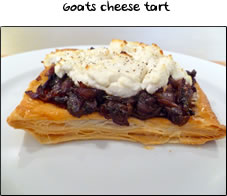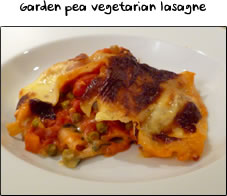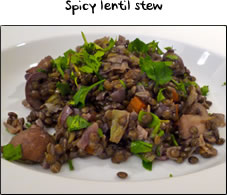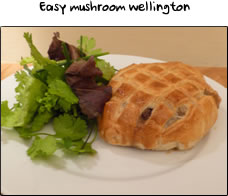Advertisement


12oz (340g) of Very Strong Wholemeal Flour
12oz (340g) of Granary Flour
1 x 7g packet of easy blend fast action yeast
1oz (30g) of cooking margarine
15fl oz (425ml) warm water
2 teaspoons of salt

preparation 1 mins • you cook for 20 mins •
Makes 1 loaf
Watch a 30 second preview of my cook-along video below
Homemade bread is something that everyone should try. The taste, the smell and the satisfaction is so great from making your own bread that you'll soon feel like a master baker. The recipe below is for a granary loaf however if you want to make a white loaf or a wholemeal loaf, use the same amounts, just use all white or wholemeal flour. I use ounces for this recipe as it was handed down from my mum, however the conversion to grams is alongside. This is a two part recipe. In part one we make and knead the dough. In part two we shape and bake the bread.
Large Bowl
Kitchen scales
Small hand whisk or fork
Baking tray

Advertisement
Before you start, have all the ingredients ready, your bowl and scales out to one side of your work surface, leaving space to knead the bread next to it. Put a small handful of wholemeal (or white if using) flour into a ramekin or small bowl. Now click here!
Before you start, have your newly risen dough on your work surface together with your ramekin of flour. Now click here!
Advertisement
This week's newsletter recipe is for my Tangy Lamb Tagine. This is a great dish packed with flavour - all you have to do is throw a bunch of ingredients in a pot and let them cook for a couple of hours and the result is magic! Slow cooked lamb shoulder, with the sweetness of apricot and the gentle heat of cayenne pepper - this dish will warm up your senses in no time.
Throughout November, the theme for my newsletters is 'Winter Warmers'. Each of this month's delicious recipes contain just enough spice to warm those winter months. I have 4 great exclusive recipes and cook-along videos for you, from Satay Pork to Curried Cauliflower Soup. With valuable cooking tips & fun food news from around the web, sign up for free today.
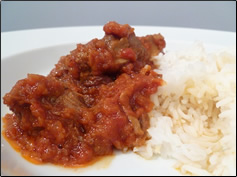
Simply enter your email address - it won't go to 3rd parties and you won't receive any junk mail!
First you need to weigh out your ingredients. 12oz of wholemeal and 12oz of granary flour into a large bowl. Add 2 teaspoons of salt and the packet of yeast. Give everything a light whisk together with a whisk or fork to mix the ingredients together.
Lightly flour your work surface whilst you have dry hands, before adding the marg to your bowl. Drop it in and then rub it together with the flour in between your hands, so that it gets roughly incorporated into the flour. Don't worry if there are still a few lumps. Next make a well in the middle of the bowl and pour in the water. Mix everything together with your fingers until you have one big sticky lump of dough.
Tip the contents onto the floured work surface and start kneading. This will take about 10 minutes, although if this is your first time making bread, it's probably best to add a couple of minutes so you can get the hang of it. To knead, use the heel of your hand and push the mix away from you, stretching the dough. At the same time, use the fist of your other hand to pull the dough towards you. Fold the dough back on itself so that you have the same rough shape as you started with, turn the dough 90 degrees and repeat this for 10 minutes. Everything is super sticky at this stage and your hands will be covered with dough but don't worry. Keep repeating the process of pushing and pulling the dough, folding it back up and turning. After a few minutes, you can start to pick the dough from your hands and knead onto it, to pick up the bits. If the dough is completely sticking to the work top, then add a little flour to your surface from the ramekin you set aside. After about 5 minutes, the texture will start to change, and the dough will be starting to stretch easier. Keep picking the bits off your hands, or lightly rub your hands together and knead knead knead for 10 minutes.
The way to tell that the dough is properly kneaded is by the fact that it will have become really stretchy and when you knead it, it stretches loads and doesn't break.
Take a large bowl, and put a little oil in the bottom and spread it around with your hands so that the bowl is lightly oiled. Put the dough into the bowl and add a little oil to the top, rubbing all over with your hands. Now all you need to do is cover the bowl with a clean tea towel and leave to rise for about 1 - 1.5 hours. An airing cupboard is perfect. The dough needs to roughly double in size, that's how you know its done.
Once the dough has doubled in size, preheat your oven to 240c and lightly flour your work surface. Tip the bowl up onto the surface, then dust your knuckles in the flour and using your knuckles, lightly punch the dough to a rough flat shape. Now all you need to do, is fold the sides into the middle, then fold the ends in slightly. Flip the whole thing the other way up (folds are now underneath) and pop on a baking tray in the oven for 40 minutes. You can tell that it's done, as it'll be crispy on the outside and if you knock the bottom, it'll sound hollow.
Transfer to a wire rack to cool and marvel in your new found bread making skills!
I hope that you enjoy it.
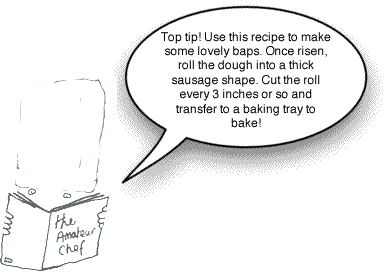
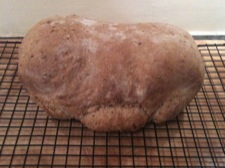
All content © 2012 TheAmateurChef.co.uk - Privacy Policy
